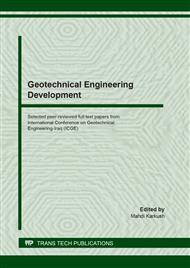[1]
H.H. Karim, M.M. Mahmood and R.G. Renka, Soft Clay Soil Improvement Using Stone Columns and Dynamic Compaction Technique, Engineering and Technology Journal, 27(14), (2009), pp.2546-2565.
Google Scholar
[2]
M.Y. Fattah, Improvement of Soft Clays by End Bearing Stone Columns Encased with Geogrids, Diyala Journal of Engineering Sciences, Engineering Sc. Conference, First, 2010, pp.310-326.
Google Scholar
[3]
J. Pivarc, Stone Columns-Determination of the Soil Improvement Factor, Slovak Journal of Civil Engineering, XIX, 3, (2011), pp.17-21.
Google Scholar
[4]
N. P. Balaam, J. R. Booker, Effect of Stone Column Yield on Settlement of Rigid Foundations in Stabilized Clay, International Journal for Numerical and Analytical Methods in Geomechanics, 9, 4, (1985), 331-351.
DOI: 10.1002/nag.1610090404
Google Scholar
[5]
N. Sabhahit, P.K. Basudhar, and R. Madhira, Generalized Stability Analysis of Embankments on Granular Piles, Japanese Geotechnical Society, Soils and Foundations, 37(4), (1997), pp.13-22.
DOI: 10.3208/sandf.37.4_13
Google Scholar
[6]
J.M.O. Hughes and N.J. Withers, Reinforcing of Soft Cohesive Soils with Stone Columns, Ground Engineering, 7(3), (1974), pp.42-49.
Google Scholar
[7]
Shinji Suzuki, Andrew D. Noble, Sawaeng Ruaysoongnern & Narong Chinabut, Improvement in Water-Holding Capacity and Structural Stability of a Sandy Soil in Northeast Thailand, Arid Land Research and Management, 21(1), (2007), pp.37-49.
DOI: 10.1080/15324980601087430
Google Scholar
[8]
Fayed A.L., Sorour T.M., Shehata H.F. (2018) Study of the Behavior of Floating Stone Columns in Soft Clay Formations Using Numerical Modeling. In: Frikha W., Varaksin S., Viana da Fonseca A. (eds) Soil Testing, Soil Stability and Ground Improvement. GeoMEast 2017. Sustainable Civil Infrastructures. Springer, Cham.
DOI: 10.1007/978-3-319-61902-6_19
Google Scholar
[9]
H.F. Shehata, T.M. Sorour and A. L. Fayed, Effect of stone column installation on soft clay behavior, International Journal of Geotechnical Engineering, (2018),.
DOI: 10.1080/19386362.2018.1478245
Google Scholar
[10]
I. Singh, A. K. Sahu, A Review on Stone Columns used for Ground Improvement of Soft Soil, Proceedings of the 4th World Congress on Civil, Structural, and Environmental Engineering (CSEE'19), Rome, Italy – April, 2019, Paper No. ICGRE 132,.
DOI: 10.11159/icgre19.132
Google Scholar
[11]
M. Miranda, A. D. Costa, Laboratory analysis of encased stone columns, Geotextiles and Geomembranes, 44(3), (2016), pp.269-277.
DOI: 10.1016/j.geotexmem.2015.12.001
Google Scholar
[12]
M.Y. Fattah, B.S. Zabar and H.A. Hassan, Experimental Analysis of Embankment on Ordinary and Encased Stone Columns, International Journal of Geomechanics, 16, 4, (2016), 145-172.
DOI: 10.1061/(asce)gm.1943-5622.0000579
Google Scholar
[13]
J. Castro, An analytical solution for the settlement of stone columns beneath rigid footings, Acta Geotech. 11, (2016), p.309–324,.
DOI: 10.1007/s11440-014-0358-4
Google Scholar
[14]
X. Li, G. Cai, S. Liu, A. J. Puppala, J.Zheng and T. Jiang, Undrained Shear Strength and Pore Pressure Changes Due to Prestress Concrete Pile Installation in Soft Clay, International Journal of Civil Engineering, 17(2), (2019), pp.193-203.
DOI: 10.1007/s40999-017-0200-0
Google Scholar
[15]
A. Dominijanni, E. Fratalocchim N. Guarena, M.Manassero and F. Mazzieri, Critical issues in the determination of the bentonite cation exchange capacity, Géotechnique Letters, 9(3), (2019), pp.205-210.
DOI: 10.1680/jgele.18.00229
Google Scholar


